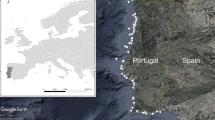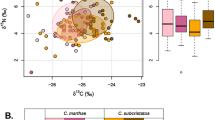Abstract
The number of individuals to be sampled is a key element in the sampling design of any study as it directly affects the estimations and inferences made. Additionally, in cases where several replicates per individual can be taken, it is important to define how the sampling effort will be distributed between the intraindividual and interindividual components (within and between individuals, respectively). Determining how samples should be distributed among these components can help optimize the available resources and reduce bias in the estimations. To study population trophic diversity, the total niche width (TNW) is usually estimated, which is an approximation of resource diversity at the population level. TNW is the sum of the resource diversity consumed at the intraindividual (replicates) and interindividual (individuals) level. In this study, the effect of prioritizing the number of individuals or the number of replicates on the accuracy and precision of TNW estimations was tested. Multiple isotopic (δ13C and δ15N) values per individual in populations with different degree of individual specialization were simulated. Then, isotopic data from natural populations within the same species (available published studies) were used to assess the results obtained with simulated data. It was found that TNW estimations were more accurate and precise when prioritizing the number of individuals over the replicates, along the entire individual gradient of trophic specialization. Therefore, it is advisable to prioritizing the number of individuals. This methodological contribution should be considered in future studies that use repeated measures of isotopic data to estimate TNW.



Similar content being viewed by others
Data availability
The datasets analyzed during the current study are available in Dryad repository (https://doi.org/https://doi.org/10.5061/dryad.k231g) and in the Australian data center (https://data.aad.gov.au/metadata/records/ASAC_2940).
References
Araújo MS, Bolnick DI, Layman CA (2011) The ecological causes of individual specialisation. Ecol Lett 14:948–958. https://doi.org/10.1111/j.1461-0248.2011.01662.x
Arend MG, Schäfer T (2019) Statistical power in two-level models: a tutorial based on Monte Carlo simulation. Psychol Methods 24:1
Barabás G, D’Andrea R (2016) The effect of intraspecific variation and heritability on community pattern and robustness. Ecol Lett 19:977–986. https://doi.org/10.1111/ele.12636
Bolnick DI, Yang LH, Fordyce JA, Davis JM, Svanbäck R (2002) Measuring individual-level resource specialization. Ecology 83:2936–2941. https://doi.org/10.2307/3072028
Bolnick DI, Svanbäck R, Fordyce JA, Yang LH, Davis JM, Hulsey CD, Forister ML (2003) The ecology of individuals: incidence and implications of individual specialization. Am Nat 161:1–28. https://doi.org/10.1086/343878
Bolnick DI, Amarasekare P, Araújo MS, Bürger R, Levine JM, Novak M, Rudolf VH, Schreiber SJ, Urban MC, Vasseur DA (2011) Why intraspecific trait variation matters in community ecology. Trends Ecol Evol 26:183–192. https://doi.org/10.1016/j.tree.2011.01.009
Cárdenas-Alayza S, Adkesson MJ, Edwards MR, Hirons AC, Gutiérrez D, Tremblay Y, Franco-Trecu V (2022) Sympatric otariids increase trophic segregation in response to warming ocean conditions in peruvian humboldt current system. PLoS ONE 17:e0272348
Cherel Y, Hobson KA, Guinet C, Vanpe C (2007) Stable isotopes document seasonal changes in trophic niches and winter foraging individual specialization in diving predators from the Southern Ocean. J Anim Ecol 76:826–836
Cherel Y, Kernaléguen L, Richard P, Guinet C (2009) Whisker isotopic signature depicts migration patterns and multi-year intra-and inter-individual foraging strategies in fur seals. Biol Lett 5:830–832
Costa GC, Mesquita DO, Colli GR, Vitt LJ (2008) Niche expansion and the niche variation hypothesis: does the degree of individual variation increase in depauperate assemblages? Am Nat 172:868–877. https://doi.org/10.1086/592998
Costa-Pereira R, Tavares LE, de Camargo PB, Araujo MS (2017) Seasonal population and individual niche dynamics in a tetra fish in the Pantanal wetlands. Biotropica 49:531–538
Costa-Pereira R, Toscano B, Souza FL, Ingram T, Araújo MS (2019) Individual niche trajectories drive fitness variation. Funct Ecol 33:1734–1745
Dalerum F, Angerbjörn A (2005) Resolving temporal variation in vertebrate diets using naturally occurring stable isotopes. Oecologia 144:647–658. https://doi.org/10.1007/s00442-005-0118-0
de Lima RC, Franco-Trecu V, Vales DG, Inchausti P, Secchi ER, Botta S (2019) Individual foraging specialization and sexual niche segregation in South American fur seals. Mar Biol 166:1–12. https://doi.org/10.1007/s00227-019-3480-x
de Lima RC, Franco-Trecu V, Carrasco TS, Inchausti P, Secchi ER, Botta S (2022) Segregation of diets by sex and individual in South American fur seals. Aquat Ecol. https://doi.org/10.1007/s10452-021-09915-9
Elliott Smith EA, Newsome SD, Estes JA, Tinker MT (2015) The cost of reproduction: differential resource specialization in female and male California sea otters. Oecologia 178:17–29
Forsman A, Wennersten L (2016) Inter-individual variation promotes ecological success of populations and species: evidence from experimental and comparative studies. Ecography 39:630–648. https://doi.org/10.1111/ecog.01357
Franco-Trecu V, Aurioles-Gamboa D, Inchausti P (2014) Individual trophic specialisation and niche segregation explain the contrasting population trends of two sympatric otariids. Mar Biol 161:609–618. https://doi.org/10.1007/s00227-013-2363-9
Franco-Trecu V, Botta S, De Lima RC, Negrete J, Naya DE (2022) Testing the niche variation hypothesis in pinnipeds. Mammal Rev 52:497–506. https://doi.org/10.1111/mam.12297
Guo Y, Logan HL, Glueck DH, Muller KE (2013) Selecting a sample size for studies with repeated measures. BMC Med Res Methodol 13:1–8
Hadfield JD (2010) MCMC methods for multi-response generalized linear mixed models: the MCMCglmm R package. J Stat Softw 33:1–22. https://doi.org/10.18637/jss.v033.i02
Hindell M, Lea M (2018) Winter foraging locations of southern ocean predators -sub-Antarctic islands, Ver. 1. Australian Antarctic Data Centre. https://researchdata.edu.au/winter-foraging-locations-antarctic-islands/700076. Accessed 12 Oct 2023
Ingram T, Costa-Pereira R, Araújo MS (2018) The dimensionality of individual niche variation. Ecology 99:536–549. https://doi.org/10.1002/ecy.2129
Kain MP, Bolker BM, McCoy MW (2015) A practical guide and power analysis for GLMMs: detecting among treatment variation in random effects. PeerJ 3:e1226
Kernaléguen L, Arnould JP, Guinet C, Cherel Y (2015) Determinants of individual foraging specialization in large marine vertebrates, the Antarctic and subantarctic fur seals. J Anim Ecol 84:1081–1091
MacArthur R, Levins R (1967) The limiting similarity, convergence, and divergence of coexisting species. Am Nat 101:377–385
Maldonado K, Bozinovic F, Newsome SD, Sabat P (2017) Testing the niche variation hypothesis in a community of passerine birds. Wiley Online Libr. https://doi.org/10.1002/ecy.1769
Manlick PJ, Maldonado K, Newsome SD (2021) Competition shapes individual foraging and survival in a desert rodent ensemble. J Anim Ecol 90:2806–2818
Martínez del Rio C, Sabat P, Anderson-Sprecher R, Gonzalez SP (2009) Dietary and isotopic specialization: the isotopic niche of three Cinclodes ovenbirds. Oecologia 161:149–159
McHuron EA, Holser RR, Costa DP (2019) What’s in a whisker? disentangling ecological and physiological isotopic signals. Rapid Commun Mass Spectrom 33:57–66
Mills WF, McGill RA, Cherel Y, Votier SC, Phillips RA (2021) Stable isotopes demonstrate intraspecific variation in habitat use and trophic level of non-breeding albatrosses. Ibis 163:463–472
Muller KE, Edwards LJ, Simpson SL, Taylor DJ (2007) Statistical tests with accurate size and power for balanced linear mixed models. Stat Med 26:3639–3660
Naya DE, Franco-Trecu V (2019) An unbiased method to estimate individual specialisation from multi-tissue isotopic data. Freshw Biol 64:1427–1436
Newsome SD, Martinez del Rio C, Bearhop S, Phillips DL (2007) A niche for isotopic ecology. Front Ecol Environ 5:429–436. https://doi.org/10.1890/060150.1
Newsome SD, Tinker MT, Monson DH, Oftedal OT, Ralls K, Staedler MM, Fogel ML, Estes JA (2009) Using stable isotopes to investigate individual diet specialization in California sea otters (Enhydra lutris nereis). Ecology 90:961–974
Noble JD, Collins SL, Hallmark AJ, Maldonado K, Wolf BO, Newsome SD (2019) Foraging strategies of individual silky pocket mice over a boom–bust cycle in a stochastic dryland ecosystem. Oecologia 190:569–578
R Core Team (2022) R: a language and environment for statistical computing. R foundation for statistical computing. Vienna, Austria. https://www.R-project.org/
Rea LD, Christ AM, Hayden AB, Stegall VK, Farley SD, Stricker CA, Mellish J-AE, Maniscalco JM, Waite JN, Burkanov VN (2015) Age-specific vibrissae growth rates: a tool for determining the timing of ecologically important events in Steller sea lions. Mar Mammal Sci 31:1213–1233
Rosas-Hernández MP, Aurioles-Gamboa D, Hernández-Camacho CJ (2019) Specialized foraging habits of adult female California sea lions Zalophus californianus. Mar Mammal Sci 35:1463–1488
Roughgarden J (1972) Evolution of niche width. Am Nat 106:683–718
Shaner P-JL, Ke L (2022) Niche overlap in rodents increases with competition but not ecological opportunity: a role of inter-individual difference. J Anim Ecol 91:1679–1692. https://doi.org/10.1111/1365-2656.13750
Sheppard CE, Inger R, McDonald RA, Barker S, Jackson AL, Thompson FJ, Vitikainen EI, Cant MA, Marshall HH (2018) Intragroup competition predicts individual foraging specialisation in a group-living mammal. Ecol Lett 21:665–673
Stewart SD, Kelly D, Biessy L, Laroche O, Wood SA (2021) Individual diet specialization drives population trophic niche responses to environmental change in a predator fish population. Food Webs 27:e00193
Taylor J, Francis R, Rush S, Strickland B, Wang G (2022) Individual trophic niche specialization in American beaver (Castor canadensis). Food Webs 32:e00235
Teixeira CR, Botta S, Cremer MJ, Marcondes MC, Pereira LB, Newsome SD, Jorge FGD, Simões-Lopes PC (2023) Ecologically driven differences in individual diet specialization across three populations of Guiana dolphin. Oecologia 201:397–408
Tredennick AT, Hooker G, Ellner SP, Adler PB (2021) A practical guide to selecting models for exploration, inference, and prediction in ecology. Ecology 102:e03336
Van Valen L (1965) Morphological variation and width of ecological niche. Am Nat 99:377–390
Vander Zanden HB, Bjorndal KA, Reich KJ, Bolten AB (2010) Individual specialists in a generalist population: results from a long-term stable isotope series. Biol Lett 6:711–714
Vejřík L, Vejříková I, Blabolil P, Sajdlová Z, Kočvara L, Kolařík T, Bartoň D, Jůza T, Šmejkal M, Peterka J (2023) Trophic position of the species and site trophic state affect diet niche and individual specialization: from apex predator to herbivore. Biology 12:1113
Wolak ME, Fairbairn DJ, Paulsen YR (2012) Guidelines for estimating repeatability. Methods Ecol Evol 3:129–137
Acknowledgements
The authors thank National Agency for Research and Innovation, Uruguay (ANII) and Postgraduate Academic Commission—UdelaR (CAP) for the MSc scholarship awarded to FHG. VFT and DEN were supported by a Clemente Estable fund 2019-156387 (ANII, National Agency or Research and Innovation, Uruguay). They also thank two anonymous reviewers for their constructive comments to a first draft of the manuscript. The funders had no role in study design, data collection and analysis, decision to publish, or preparation of the manuscript.
Funding
This work was supported by the MSc scholarship number #POS_NAC_2022_1_173718 awarded to FHG by the Agencia Nacional de Investigación e Innovación (ANII) and by the Comisión Académica de Posgrado (CAP). VFT was supported by a Clemente Estable fund 2019-156387 (ANII).
Author information
Authors and Affiliations
Contributions
The idea and designed methodology were conceived by FGDL, VFT, and DEN; VFT collected the samples; FGDL, VFT, and DEN analyzed the samples and data. All authors contributed critically to the drafts and gave final approval for publication.
Corresponding author
Ethics declarations
Conflict of interest
The authors have no competing interests to declare that are relevant to the content of this article.
Ethical approval
Databases of natural populations that were already available in online repositories were used. Therefore, no ethical approval is required.
Additional information
Responsible Editor: P. Kraufvelin.
Publisher's Note
Springer Nature remains neutral with regard to jurisdictional claims in published maps and institutional affiliations.
Supplementary Information
Below is the link to the electronic supplementary material.
Rights and permissions
Springer Nature or its licensor (e.g. a society or other partner) holds exclusive rights to this article under a publishing agreement with the author(s) or other rightsholder(s); author self-archiving of the accepted manuscript version of this article is solely governed by the terms of such publishing agreement and applicable law.
About this article
Cite this article
Garrido-de León, F., Naya, D.E. & Franco-Trecu, V. Individuals matter more than replicates: distribution of sampling effort in isotopic niche estimation. Mar Biol 171, 97 (2024). https://doi.org/10.1007/s00227-024-04410-9
Received:
Accepted:
Published:
DOI: https://doi.org/10.1007/s00227-024-04410-9




